How Educational Technology is Revolutionizing the Learning Experience
Technology has changed how we learn, making it more fun, quick, and easy to get. The COVID-19 pandemic made us see how important online learning is. It’s now a big part of our education, with tools, platforms, and classrooms going digital.
Technology lets us learn in ways that fit each student’s needs. It makes learning more exciting and prepares students for today’s world. We’re seeing new tools like virtual reality and AI in schools, changing education fast.
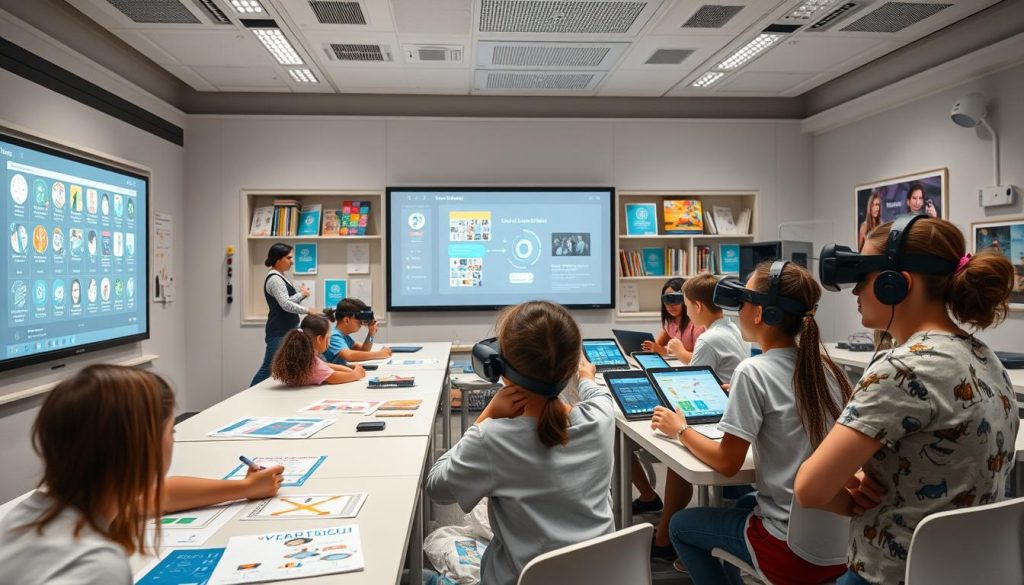
Technology is shaping the future of education in big ways. It helps teachers and students learn better together. With digital tools, we can make learning personal, fun, and open to everyone.
Understanding the Digital Revolution in Modern Education
The digital revolution has changed education a lot. It moved from old textbooks and lectures to new digital platforms. This change helps students get ready for a world that’s all about technology.
Now, students learn in ways that fit their own needs and interests. This is thanks to blended learning, virtual classrooms, and other new tech tools. These tools make learning more personal and fun.
Digital platforms offer special features that change the level of difficulty based on how well students do. This means students get the right amount of challenge and stay engaged. It also helps them learn to think critically, solve problems, and work together.
This new way of learning can also reach students in far-off places. It lets them get top-notch education and resources, even if they’re far away. Teachers use digital tools to make learning better, getting students ready for the digital job market.
It’s important to study the digital revolution in education. This helps teachers get better and helps everyone understand how technology changes learning. As education keeps changing, we need to find the best ways to keep students interested, thinking deeply, and doing well in school.
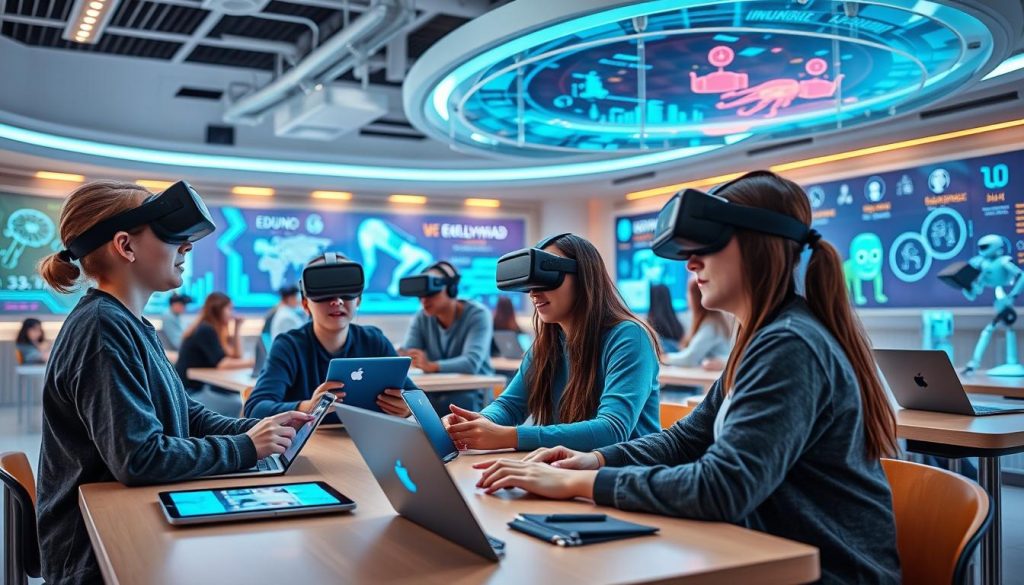
The Rise of Educational Technology in Contemporary Classrooms
The modern classroom is changing fast, thanks to edtech tools and digital classrooms. Today, students have access to lots of resources online. They can find everything from online textbooks to interactive learning activities.
Smart boards are a big change in classrooms. They let teachers create engaging lessons with images, videos, and more. Students get to interact with the content, improving their critical thinking and problem-solving skills.
Computer labs are where students learn to code and program. These skills are useful in many industries. By using technology in class, teachers can help students become more collaborative, creative, and communicative.
Edtech tools and digital classrooms have changed education a lot. With rising costs of higher education, online learning is becoming more popular. It offers a cheaper way to learn compared to traditional classes. The pandemic has also made digital learning platforms and virtual classrooms more common.
But, there are challenges to using technology in class. Issues like digital accessibility and the digital divide need to be solved. Educators also need good training. Despite these challenges, edtech has the power to change education for the better. The future of learning will likely be more tech-focused.
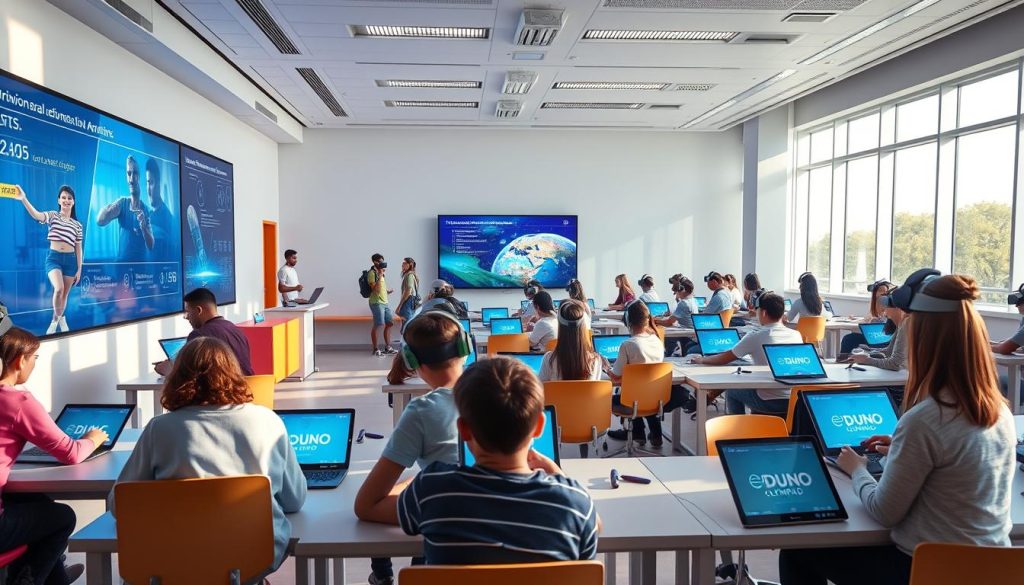
Smart Boards and Interactive Learning Environments
The digital revolution has changed classrooms a lot. Smart boards are now key in educational technology. They make learning fun and interactive.
Smart boards let teachers show content in new ways. They help teachers teach in ways that fit different learning styles. This keeps students interested and motivated.
Smart boards make teaching more collaborative. Teachers can use multimedia and digital tools together. This creates a rich learning space. Students get to share and learn together.
The SMART Technologies Pilot Project in Botswana shows smart boards’ impact. It improved learning in 5 schools. Students became more engaged and did better in school.
As schools move to digital classrooms, smart boards will be crucial. They empower teachers and engage students. These tools can change how we learn, making it more dynamic and personal.
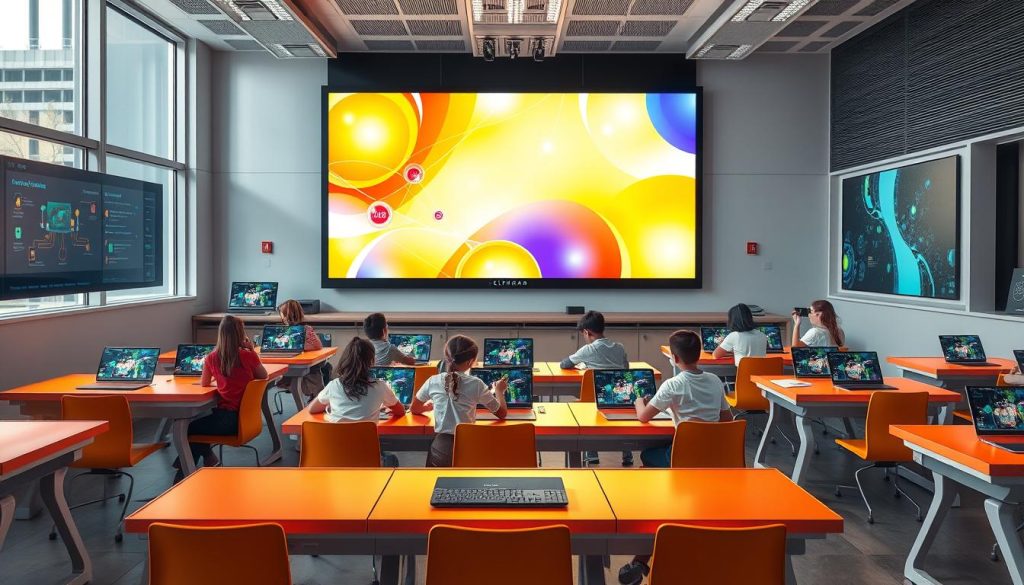
Virtual and Augmented Reality in Education
Virtual Reality (VR) and Augmented Reality (AR) are changing how we learn. They bring learning to life in ways we never thought possible. VR lets you explore places and times you’ve never seen before. AR adds digital information to the world around us, making learning fun and interactive.
These tools can make learning more engaging and effective. Studies show that AR/VR can increase student interest and understanding. They also help students do better in school.
But, using VR and AR in schools comes with its own set of challenges. Not many devices can handle seamless AR experiences. Schools need to spend a lot to get the right equipment for VR. Also, finding good educational content for VR is hard.
- VR can offer immersive experiences of historical events, while AR superimposes scientific data onto the real world, aiding comprehension of complex concepts.
- AR encourages interactive learning by blending digital components into the physical world, promoting active engagement with subject matter.
- VR provides experiential learning opportunities and safe environments for practical training, particularly beneficial in fields like medicine and engineering.
Despite these hurdles, VR and AR are making a big difference in education. Places like Stanford University are studying how VR affects learning and empathy. Google Expeditions also lets students go on virtual field trips, expanding their learning beyond the classroom.
As VR and AR become more common in schools, they’re shaping the future of learning. They offer exciting ways to learn and understand complex subjects.
Artificial Intelligence and Machine Learning Applications
Artificial intelligence (AI) and machine learning are changing education. AI tools are making learning more personal and teaching more effective. This marks a new era in education technology.
AI can look at lots of data to understand how students learn and what they like. It can handle boring tasks, make lessons just for each student, and give feedback right away. AI can even adjust the level of quizzes and homework based on how well a student does, making learning more tailored.
- AI-powered platforms can analyze vast amounts of data to provide personalized learning experiences, predict student performance, and offer tailored recommendations for improvement.
- AI tools assist in automating administrative tasks, allowing teachers and educational institutions to focus more on teaching and less on paperwork.
- AI-driven personalized learning experiences are tailored to meet the individual needs of each student, adapting the curriculum in real-time based on student interactions and performance.
While AI in education has many benefits, we must think about privacy and fairness. As AI becomes more common in schools, it could greatly change how we learn. This could make education more personal and effective for everyone.

Mobile Learning and Digital Accessibility
In today’s digital world, mobile learning (m-learning) is changing education. It uses smartphones, tablets, and wearables to let students learn anytime, anywhere. This way, students can learn at their own pace and outside of school.
Mobile learning makes education more accessible. Digital classrooms help all students, including those with disabilities. They use things like videos, virtual reality, and adaptive tools to meet different learning needs. This creates a welcoming space for everyone to learn.
- Mobile learning cuts down on the need for textbooks, making education cheaper and more accessible.
- Multimedia in m-learning makes learning more fun and helps students remember what they learn better.
- But, there are challenges like the digital divide, making sure content is good, and dealing with distractions from mobile devices.
As we get more connected, m-learning can help close educational gaps and support lifelong learning. It lets students learn on the move, changing education for the better. This makes learning more fair and fun for everyone.
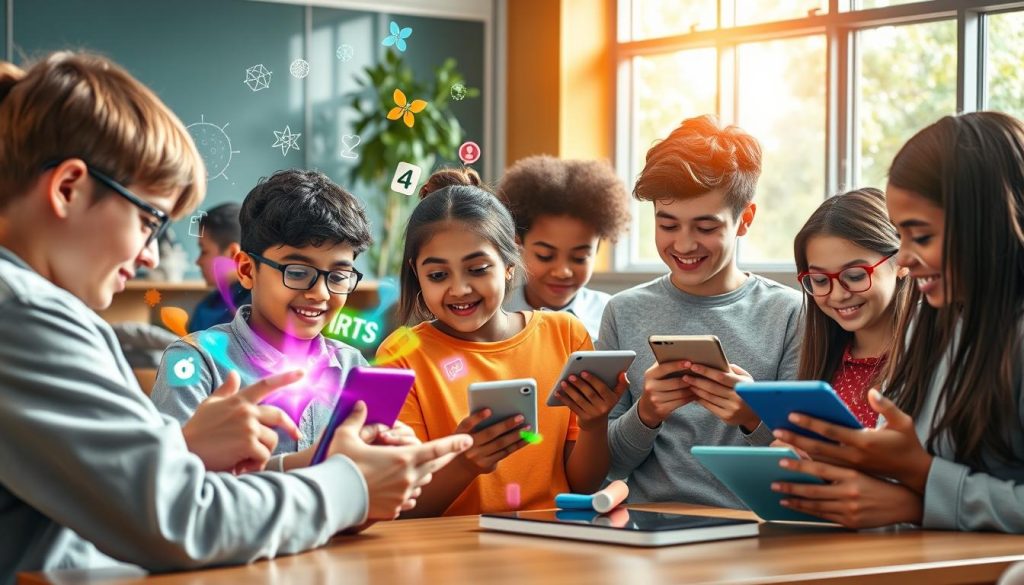
Gamification and Educational Gaming Platforms
Gamification is changing education, making learning fun and effective. It uses game design to engage students. This approach makes learning enjoyable and powerful.
Educational gaming platforms lead this digital change. They use technology to create interactive learning spaces. These platforms add points, badges, and competition to motivate students.
Gamification works in many subjects, teaching important skills. It helps students solve problems, think critically, and be creative. Students get instant feedback, helping them improve and track their progress.
Recent stats show 99% of K-12 schools use gamification in education since 2020. The edtech tools market hit $297.56 billion in 2022. It’s expected to grow to $696.04 billion by 2028, showing gamification’s big impact.
Interactive quizzes, leaderboards, and virtual experiences are just the start. Gamification and edtech tools help educators create engaging, personalized learning. This approach keeps students interested and encourages a love for learning that lasts.
Learning Management Systems and Online Platforms
In today’s world, learning management systems (LMS) and online learning platforms have changed education. They make learning easy and fun. They help teachers and students talk and share work easily.
Platforms like Moodle, Blackboard, and Canvas are key in modern classrooms. They offer many tools for managing courses. These tools include interactive materials, tests, and ways to communicate.
Online learning platforms are also popular. They have many courses for different learners. You can learn new things or improve your skills from home.
The mix of LMS and online platforms has been a big help, especially during the pandemic. They let students keep learning online without losing quality.
Looking ahead, LMS and online platforms will keep changing education. They will help make learning more personal and fun. This will help students grow and succeed.
Personalized Learning Through Technology
The field of education is changing fast. Personalized learning technology is leading this change. Schools and universities are now using new edtech solutions to meet each student’s needs.
Adaptive learning algorithms are key to this new approach. They look at how students are doing and adjust the lessons. This way, students get content that fits them, learn at their own pace, and get feedback that helps them grow.
- Learning Management Systems (LMS) offer a place for personalized content, feedback, and tests.
- Adaptive learning platforms use smart algorithms to create learning paths based on how students perform and learn.
- Data analytics tools help teachers see how students are doing and give them the right help.
- Immersive tech like virtual and augmented reality makes learning more fun and helps students remember more.
By using personalized learning technology, teachers can help students learn on their own. This method not only helps students do better in school. It also teaches them important skills like thinking critically, communicating well, and being adaptable.
As education keeps changing, personalized learning technology will be more important than ever. It will help make sure every student gets the support and chances they need to succeed. The future of learning is all about being personal, and edtech is making that future bright for many students.
Digital Assessment and Feedback Tools
The digital world has changed how we test and give feedback in school. Educational technology (edtech) tools have made testing better, giving teachers many ways to check if students are learning. These tools help teachers make quizzes, projects, and multimedia tests that show how students are doing right away.
One big plus of digital testing is that it can adjust to how well students are doing. This makes learning more personal. These tools also help teachers collect and analyze lots of data. This way, they can see how students are doing over time and improve teaching.
With digital feedback, students get quick updates on their progress. This helps them keep learning all the time. Using edtech tools with systems for learning and student info makes testing easier and more efficient. This helps teachers make better choices based on data.
Digital testing tools bring better security, flexibility, and fairness to checking student work. By using these new technologies, teachers can make learning more fun, interactive, and effective. This prepares students for a world that is more digital than ever.
Emerging Trends in Online Education
The world of online education is changing fast. New edtech solutions are making learning better. We’re seeing AI chatbots and virtual classrooms that make learning exciting.
AI-powered chatbots are becoming a big deal in online learning. They answer student questions right away. Microlearning, which breaks content into small chunks, is also getting popular. It’s efficient and flexible.
Blockchain technology is being used for secure credentials. It makes sure educational certificates are real. Soon, 5G networks will make online learning even better, especially for VR and AR.
Edtech innovations and start-ups are leading these changes. They’re making learning more flexible and personal. This means online education will get even better.
The EDUNO OLYMPIAD shows how digital education is the future. These trends will bring us a more connected and personalized learning experience worldwide.
Conclusion
Educational technology has changed how we learn, making it more engaging, personal, and accessible. Tools like smart boards and AI systems have updated our classrooms. Despite challenges like the digital divide and teacher training needs, the benefits are clear.
We must use these technologies wisely, making sure they don’t replace human touch in learning. The future of education combines tech with teaching methods for better learning spaces. This is key for students, including those in the EDUNO OLYMPIAD.
By using educational technology, we can make learning more fun, tailored, and open to everyone. The shift to tech in education is thrilling. With ongoing efforts, we can fully realize the digital classroom’s potential.
Frequently Asked Questions (FAQ)
How has technology transformed traditional teaching methods?
Technology has made learning more fun and easy to get. It has moved from old textbooks and lectures to digital platforms. This change helps students learn in a way that fits them best and prepares them for a tech-filled world.
What is the role of smart boards in modern classrooms?
Smart boards are key in today’s classrooms. They help teachers show educational content and get students involved in learning. This supports different learning styles and encourages students to learn actively.
How are Virtual Reality (VR) and Augmented Reality (AR) revolutionizing education?
VR and AR bring learning to life by taking students on virtual trips or adding digital layers to the real world. These technologies make learning more engaging and offer hands-on experiences, enhancing the learning process.
How is Artificial Intelligence (AI) and Machine Learning transforming education?
AI and Machine Learning make learning personal by analyzing student data and giving feedback quickly. They help find learning gaps and tailor lessons to each student. However, there are concerns about privacy and bias.
What is the impact of mobile learning on education?
Mobile learning, or m-learning, is popular because it’s flexible and easy to access. It lets students learn anytime, anywhere. This supports self-paced learning and ensures everyone, including those with disabilities, can use educational technology.
How does gamification enhance the learning experience?
Gamification uses game design to make learning fun. Educational games engage students, improve problem-solving, and boost creativity. They also give instant feedback on progress.
What is the role of Learning Management Systems (LMS) and online learning platforms?
LMS and online platforms are crucial in education today. They help deliver content, assess students, and connect teachers and students. These platforms offer many courses and programs, making education accessible to more people.
How does technology enable personalized learning experiences?
Technology tailors learning to each student’s needs and preferences. It uses algorithms to adjust the curriculum based on student progress. This approach boosts engagement and academic success, empowering students to take charge of their learning.
What are the emerging trends in online education?
New trends in online education include AI chatbots and virtual assistants, microlearning, blockchain for secure credentials, and 5G networks for better online learning. These advancements aim to improve the quality and reach of online education.
